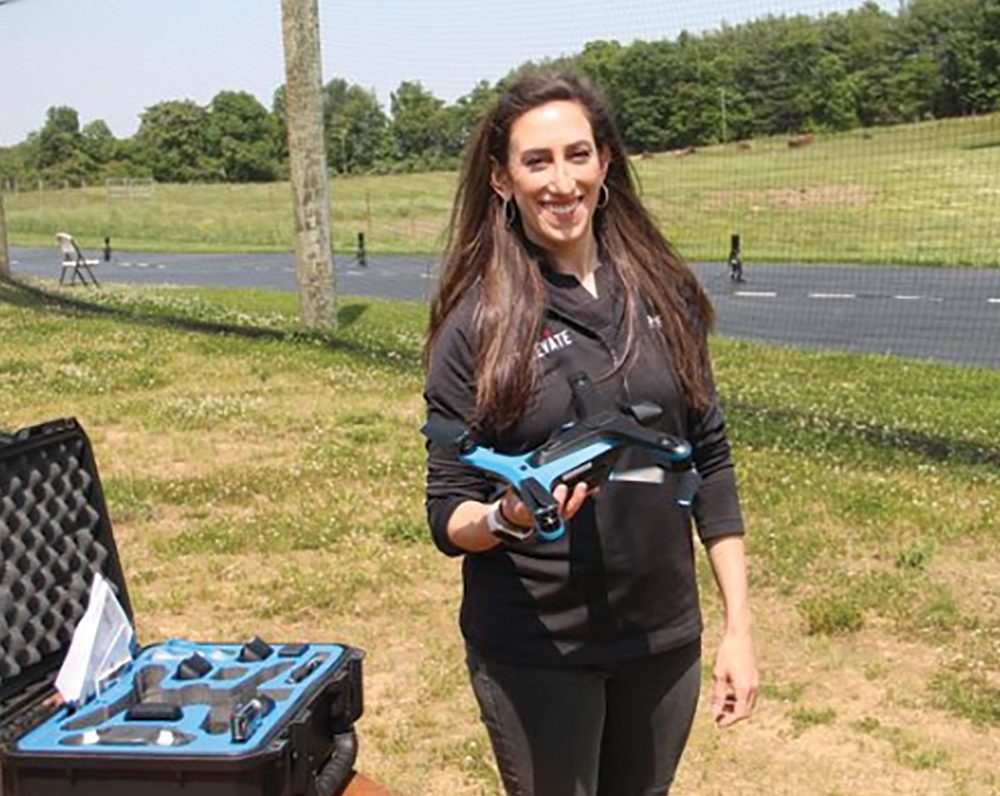Focus: Eastern region, from the ground up
Educational partnerships create jobs across the east’s 29 counties — including one county that is up in the air.
—By Kathy Blake
The NC East Alliance economic development organization is initiating a homegrown approach through educational resources to create a continual, skilled workforce in its 29 Coastal Plain counties.
STEM East connects school district faculties and superintendents, and leadership of 10 community colleges, with employers for careers that utilize science, technology, engineering and math.
“NC East is the only regional economic development organization focusing on our 13,000 teachers in 29 counties as a workforce,” says Vann Rogerson, the Alliance’s president and CEO.
The Alliance’s Industry in Schools career clusters for FY 2023-2024 will train teachers and faculty through public-private partnerships so they can educate students in career-specific pathways.
California-based BelleJAR Foundation has pledged $1.6 million to help. The Alliance received the first of four annual checks – $400,000 – in 2023 from the foundation, which seeks “unique and innovative approaches to improve educational outcomes for underserved students,” according to its website.
Industry in Schools “provides an opportunity for teachers to engage with regional industry to design instructional programming and classroom activities that align with curriculum standards,” according to the STEM East website.
While funding for Industry in Schools remains an agenda item with the state legislature, some events are taking place. “We’re coming together to solve workforce issues in the region,” says Trey Goodson, the Alliance’s regional economic developer and director of marketing and communications. “Some areas are health science, aviation sciences, agriculture, advanced manufacturing, the blue economy – boat building, marine trades, tourism – and renewables and alternative energies.”
Last summer, NC East Alliance hosted workshops in health sciences, at Pitt Community College; aviation science, at Craven Community College; and smart agriculture, at James Sprunt Community College in Kenansville.

Unmanned technology is revolutionizing industries like agriculture.
While other announcements are forthcoming, Goodson says, “Through these programs, we help teachers learn about these job opportunities and training opportunities for their students to pursue some long-term careers in eastern North Carolina that people may not be aware of.”
One area with multiple jobs is agriculture.
Gary Roberson is a distinguished professor and cooperative extension specialist in the Biological and Agricultural Engineering Department at N.C. State. North Carolina has 8.4 million acres of farmland and leads the country in tobacco and sweet potato production. Agriculture contributes about $76 billion to the state economy.
“I have worked with the STEM East program. Agriculture is changing. It is no longer a business where you can learn all you need to know by just listening to your parents or neighbors,” Roberson says. “The modern farmer is part businessman, entrepreneur, crop and soil scientist, machinery technician, personnel manager and marketing specialist. The list could go on and on. We need to increase our productivity in order to continue to meet the demands of a growing world. At the same time, we need to be good stewards of our resources for efficient production. This will require a well-prepared farm community and a well-prepared support community. Farmers will need support services they can depend on to keep modern machinery running at peak efficiency. The demands and opportunities for a local workforce are certainly there.”
Beaufort County on the banks of the Pamlico River also sees “demands and opportunities,” with incoming industries and an undertaking at its Washington-Warren Airport that will have ripple effects throughout Alliance territory.
“All of what makes North Carolina great are on display here in Beaufort County, where we add in a top-notch quality of life with a coastal/river environment and small town feel that is just 25 minutes from Greenville and less than two hours to Raleigh,” says Brad Huffman, director of Beaufort County Economic Development. “Companies are discovering that there is great opportunity here, such as BTW Global which relocated here recently as well as Elite Truck which is investing in a new headquarters in downtown Washington and scaling up its workforce.
One field ripe with opportunities recently landed at Beaufort County’s airport.
FOREVER FIRST IN FLIGHT
Until recently, Washington-Warren had a 5,000-foot active runway and 5,000-foot crosswind runway; five conventional and five hangar complexes; a 39-acre solar farm and a terminal building with rocking-chair front porch, dedicated in 2015.

Washington-Warren Airport to become the first Drone-Smart airport on the East Coast.
“There are 72 airports in North Carolina, and 62 that are general aviation like ours, so we’ve been operating at a loss for as long as anyone can remember,” says airport director Earl Malpass. “So, I’ve been trying to put some things in place that would help us to, one, be self-sufficient and, two, provide jobs to Washington and Beaufort County. So, what’s our niche? What’s surrounding us?
“We started looking into the future. North Carolina is known as First in Flight and is third or fourth in the nation in the aerospace business, so looking at what I believe is the next frontier in aviation is drone operation.”
Xelevate Unmanned Systems of Excellence, an Unmanned Aircraft Systems [drone] testing, development and training center in Leesburg, Virginia, partnered with Washington-Warren in 2022 to make it the first “Drone Smart” airport on the East Coast – a commercial location for unmanned flight operations.”
“Forever First in Flight is the term we’re using,” Malpass says. “It’s important that everyone understands that Washington is not becoming a ‘drone airport,’ but an airport that has integrated drone use.”
Xelevate’s presence is expected to impact many factors of coastal life.
“Creating a workforce to complement the drone industry will be a long-term effort and include not only Beaufort Public Schools, Beaufort County Community College but East Carolina University as well,” Huffman says. “Xelevate’s partnership has helped draw attention to Beaufort County and the unique value proposition that we have here. [We] exemplify all the great characteristics that have made the state of North Carolina a consistent and recognized leader in economic development. Our strategic location at the mid-point of the Eastern Seaboard, where a large percentage of the U.S. population is within a day’s drive; a competitive tax environment and low cost of doing business; as well as support from the community college and university system makes our state the envy of most.”
“We plan to partner with companies like Xelevate to grow a local, homegrown workforce in adjoining counties,” Rogerson says. “When companies come to Beaufort County for testing, manufacturing and software development, NCEast Alliance’s Industry in Schools Initiative will partner and grow local workers for the company’s future multi-county labor shed. We look forward to supporting Xelevate’s development and growth in the eastern region.”
Marcy Eisenberg is president and co-founder of Xelevate, a company created “because we saw a gap in the industry of unmanned systems,” she says. “About 80% of the market is foreign-owned.

Marcy Eisenberg, president of Xelevate Solutions, poses with a drone. Her company is finding new uses for unmanned aircraft.
“From a national security standpoint, we need to have American-made, born in the USA technologies, so we created Xelevate for aviation, national security, workforce development and education all wrapped into one.”
Think First in Flight on caffeine.
“This whole market has been like drinking from a firehose; it’s moving so incredibly fast,” Eisenberg says. “Obviously the defense market has a big interest in this, but because drones can be a fraction of the cost and solve complex issues we haven’t seen in the past, you see commercial markets starting to use them. Real estate, insurance, agriculture – these are starting to use drones in their business clusters in the area.”
Roberson emphasizes UAV [unmanned aviation vehicle] importance in agriculture. (The term UAV refers to the vehicle alone, where as UAS includes ground control and communications units.)
“The UAV is flown over the field and captures images of the entire field. These images are stitched together to form a composite image, which is then analyzed to tell us something about the crop’s health or status,” he says. “Images are captured with either an RGB camera, the same type of camera in a cell phone, or a multispectral camera which can also include near infrared or red edge bands. The imagery, after processing, can be used to estimate plant stands, plant biomass, health or vigor, track weed populations or look for plant stress, such as insects, disease, drought or other factors.”
Then, there’s weather.
“Part of the reason we wanted to be engrained in North Carolina is the hurricane response teams,” Eisenberg says. “N.C. DOT can use drones to fly radios over distraught areas and have conversations with people. They can use drones to start delivering water and medicines and things of that nature. The best part of drones is they are the next flying cell phone.”
Washington-Warren received $20 million in state funding in 2022 for a new landing system, runways and taxiways. Upgrades could generate about 1,000 jobs in contract work, and the aerospace and marine industries. The airport purchased an adjacent 107 acres for an aerospace industrial park; added water, sewer and electricity at a new corporate jetport and mapped plans for future hangars. Lights were added to the runways.
Further modernization, Malpass says, include adding fiber and a 5G antenna, “so companies can send data where they need to, securely. An additional project is we’re the first and only general aviation airport with drone detection service. Verus Technology Group partnered with us and installed a drone detection system so pilots can detect drones within 2 miles.
“Third, we purchased LiDAR wind detection system, which monitors from 3 feet to 1,000 feet, and that’s important because the drone customers want to know if the winds are more critical at a certain altitude. We’re only the fifth airport in the nation using LiDAR,”
she says.
Eisenberg says Xelerate is exploring working with Hyde and Dare counites and the N.C. Department of Transportation in DFR (drone as a first responder) and the FAA’s Beyond Visual Line of Sight applications.
A few years ago, Eisenberg says, Xelevate conducted a pilot flight over Ocracoke that lasted 20 minutes. The drone carried bottled water.
“Essentially it was a DFR, and it can become part of an emergency response team,” she says. “We are working with Hyde County to potentially utilize some of that area for additional innovation work. This is a regional initiative, not just at the airport. The airport is Ground Zero. North Carolina was First in Flight and it will be First in Flight, forever.”
Last year, the N.C. DOT received a first-of-its-kind waiver from the FAA “to remotely launch and fly drones beyond the pilot’s visual line of sight for construction project inspections,” according to a DOT release.
The release states: “NCDOT Division of Aviation is piloting the use of docked drones with the private firm Skydio, one of 18 partners in its Beyond program. NCDOT is one of eight U.S. teams testing and demonstrating how drones can be safely used for business and government purposes to inform the Federal Aviation Administration’s regulation of these rapidly advancing technologies.”
One facet of Beyond is community engagement – collecting, analyzing and addressing community concerns. “The imagery lets you see from a disaster perspective,” Eisenberg says.
HIGHER EDUCATION
In addition to Beaufort schools, Elizabeth City State University’s bachelor’s degree program in Unmanned Aircraft Systems began in fall 2019. The university also offers a bachelor’s in Aviation Science with a concentration in UAS. “Many students in the Aviation program take courses offered in the UAS program as their electives,” says Dr. Chandra Asthana, UAS program coordinator and associate professor. ECSU has since introduced a minor in UAS and certificate in UAS.
“ECSU has a strong partnership with Wake Tech for drone training to provide education, training, workforce development, outreach and applied research,” Asthana says.

Xelevate and the Washington-Warren Airport hosted the UNCW Upward Bound program high school students. The students learned about careers in manned and unmanned aviation. This opportunity was made possible by Dr. Arik King and the Future Kings organization.
“A reality-based simulation center for Basic Law Enforcement Training, including a driver training track and a 4D immersive training village will come up soon. This facility will become the new home of Wake Tech’s EMS program and a new program in Unmanned Aircraft Systems UAS.”
He says the school also is working with a NASA workforce development grant and since 2019 has engaged in summer programs “to provide educational experiences to school children.”
In the future, he says, “We are going to have a bigger building for the Aviation and Emergency Management department that will have more space for UAS labs and lecture rooms. We have many virtual simulation facilities for UAS. In addition, we have a variety of drones that students have hands-on experience with. Some of them are flown with remote controllers while some of them are flown in automated mode for which students make mission plans before launching them in the field.
“The expectation is to have multidirectional growth of UAS program providing many opportunities to the students for employment as well as
starting up business of their own.”
HELP IS IN THE AIR
“This is what we’re doing here: We’re here so we can forge into the future with an initiative of policy and technology and provide the consulting to minimize risk and maximize innovation,” Eisenberger says. “That’s why we’re at the airport, to continue to build in this emerging market.”
“With NC East, the goal is to strategically partner with them,” she continues. “With schools, we’re partnering with how to build UAVs, do the software, do the body, flight operations. These are going to allow eastern North Carolina to plug in a new way to help this market. Start the students young, have them introduced to aviation science early and computer science, and they’ll learn the concepts as they go through school. At Xelevate, we don’t build the drones; we help people. It’s an emerging market, the supply is out there and people in the communities can find ways to plug in.”

Wilmington International Airport serves southeastern North Carolina with major commercial and general aviation services. The airport is serviced by American Airlines, Avelo Airlines, Delta, Sun Country and United.
Hufford says new companies are one ingredient in pushing Eastern North Carolina forward. But there are others.
“I think the biggest challenges we have in eastern North Carolina are to reverse the population trends that have seen population diminish in the east while communities in the Triangle, Charlotte region and Triad have experienced explosive growth the last few years,” he says. “I think North Carolina needs to balance growth to all parts of the state, and there is no better place to do that than in Eastern North Carolina. To do that, investments need to be made in infrastructure like roads and utilities, affordable housing options and economic development sites and buildings.
“I think the biggest goal is to grow in relation to the state’s overall growth numbers. If we can begin to attract new companies at the size and scale that the Piedmont has, then we will see population growth and help develop communities that to date have seen decline and reduction in residents. I have always contended that our region suffers from a branding and marketing challenge. Too many people only know us through East Carolina University and vacations at the coast, but there is so much more. There are homegrown entrepreneurs doing incredible things. We have diverse communities and a growing Latino population as well as many retirees from all over the country that have discovered places like Washington, Belhaven and Chocowinity. If the eastern N.C. counties and political leadership came together and worked toward a common goal, I think we can be the next region that gets the attention of businesses as well as relocating workers.” ■

